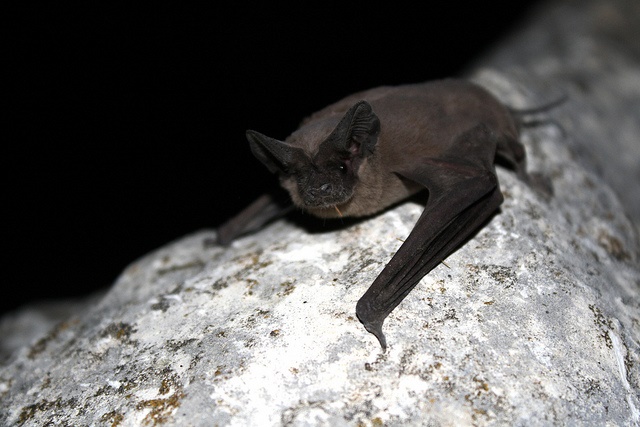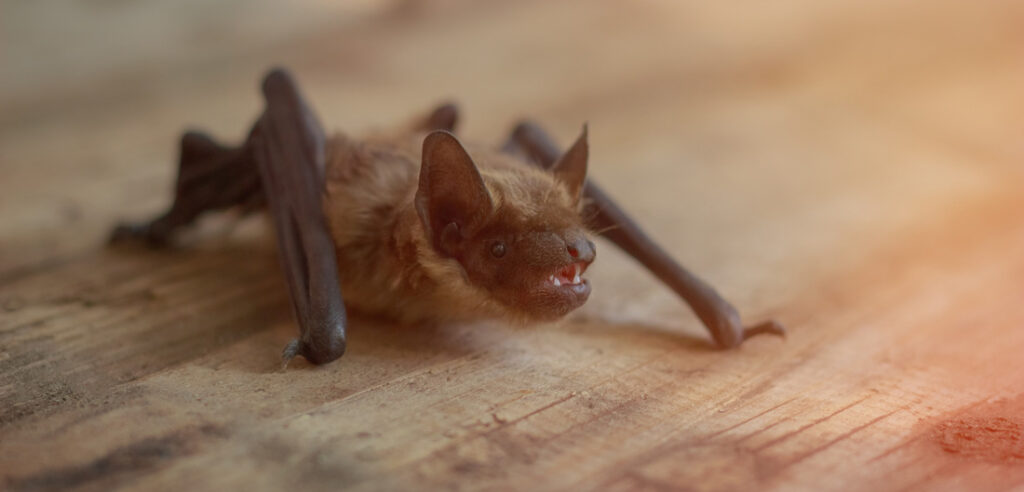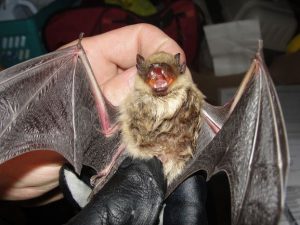Bats
Bats are flying mammals that serve a very useful purpose: they eat enormous quantities of insects. In the summer, they can find their way into homes—typically in roof eaves, in crevices around the roof covering, in the attic, or under siding—where they roost in large groups called colonies. They can enter through an opening as small as 6 mm wide. Bats usually settle near a body of water
Do not let them take up residence anywhere in your home—not even in the attic. The presence of bats, their feces (commonly referred to as guano) and urine, as well as the parasites they carry, will result in unsanitary conditions.
A further concern is rabies transmission: a very rare occurrence, but still a possibility. In the evening or at night, when bats are active, one or two may involuntarily find themselves inside your house. If this happens, they must be got rid of.
Are bats useful or bothersome?
A single bat can devour thousands of mosquitoes and other insects in one hour.
Their activity allows for reduced use of insecticides in farming areas and, in turn, less ground and water pollution.
Bats are natural eliminators of stinging and biting insects that are recognized carriers of diseases like West Nile virus, Lyme Disease, etc.
If a single bat is loose in your house:
Before you begin, put on a pair of leather work gloves.
Open doors and windows and wait for the bat to fly out on its own. If the bat is there in the daytime, leave all indoor lights off; the bat will leave when night falls.
If this doesn’t work, try to capture the bat and release it outside.

The Ultimate Repellent Guide: How to Get Rid of Bats From Your Attic or Household
You’re here because bats in your household are giving you headaches, right? That’s bad news, but we’ve got some good news for you now: after reading this article you’ll know exactly what steps you need to take to make this problem a thing of the distant past. This guide is suitable for you if you’re looking for information on how to get rid of bats in your attic without incurring thousands of dollars in removal costs. On our website, you will learn the different methods that we and other professionals use to get rid of these foul beasts safely and efficiently.
Whether you’re a D.I.Y kinda guy/gal, or just want to get the professionals in to remove your little flying friends quick-smart, the following information will guide you in the right way. Click the links in the table of contents to jump to the correct section
Bat Facts – What You Need to Know
Bats are winged mammals most commonly known for their habitation of caves and consumption of various insects over the course of the night. These animals, many of which are either threatened or endangered depending on the species, provide a great deal of color to the nig
Where Do Bats Live? (when not in your attic or home)
Bats most commonly roost in caves, which provide a safe, enclosed area for them to sleep and raise their young. But they don’t always utilize a cave. Mexican free-tailed bats, for example, can create a roost in almost any environment provided it is dark and shut-in. This flexibility in habitats means that your home could be at risk for a colony invasion. And since a bat colony can contain anywhere from 40 to twenty thousand bats, the damage done to your home can be extensive.
Evidence That You May Have Bats In Your Attic or Home
Bats seek the safety of dark, enclosed areas like caves to raise their young, called pups, However, when a cave is not available or overpopulated, bats will turn to the household attic because it most resembles a cave. An attic may even have some advantages over a cave because of the reduction in predators and the advantage of height. If you want to learn more how to remove the bats yourself (DIY)

Bat in Your House? Here’s How to Get it Out.
You’re watching TV or making dinner when you hear the flapping of wings. Imagine your surprise when you discover it’s not a bird — but a bat that’s found its way into your home! Nobody likes uninvited guests. But compared to common pests like flies, ants or mice… a flying bat circling above you is universally spooky. That’s because these winged creatures have developed a reputation as disease-carrying pests out to infest your home.
Here’s the truth: Despite their prominence in horror films and Halloween decorations, bats are actually beneficial for the environment. In fact, bats are crucial to insect control, pollination and seed dispersal. And according to the Centers for Disease Control and Prevention (CDC), less than 10% of bats tested for rabies are actually infected.
HOW DO BATS GET IN THE HOUSE?
A lost or curious bat can fly into your house through open windows or doors. If that’s the case, odds are it’s looking for a way out. But a more common reason bats invade your living space is to find a place to have babies in the fall or spring. Whatever the time of year, bats can sneak in through an entry point as small as 3/8 of an inch wide. This includes gaps in your siding, roof or soffit, as well as chimneys and attic vents. And if they make themselves at home, there’s no limit to how long they’ll stay.
HOW TO GET RID OF A BAT IN THE HOUSE
Whether you have a rogue flyer or a momma bat in the attic, use these bat removal tips to help it get back outside — and out of your living room:
Wear the proper protective gear. When handling a bat, never use your bare hands. Wear gloves (thick leather gloves are best), clothing and even a mask to protect yourself from bites. Bats aren’t typically aggressive, but it’s always best to play it safe.
Keep calm. When trying to remove a bat from your home, do your best to stay calm. Avoid making loud noises (like screaming, “There’s a bat in my house!”) or chasing the animal. It’s also a good idea to remove any pets from the room. An excited or panicked bat will be more difficult to catch.
Trap and release. The easiest way to release a bat back into the wild is to trap it in a box or container. Start by waiting for the bat to land (likely a place it can hang). Quickly place a plastic container or cardboard box over the bat. Then, slide a piece of cardboard or thick paper under the box and release the bat outside. When releasing the bat, try to let it go near a tree so it can climb (most bats can’t take flight from the ground).
Contact a local professional. Bats are a protected species in many states. If you aren’t confident in handling the situation yourself, contact a local pest control specialist for help. This is one of the safest options, too, especially if your bat problem persists
IS A BAT LIVING IN MY HOUSE?
Bats prefer to roost in high places, like attics, chimneys or porch ceilings. Bats are typically quiet animals, although you might hear squeaking or scratching noises when they’re on the move. The telltale sign of where bats are roosting is their droppings – they look like mouse droppings, but larger. You might also find rub or scratch marks at the point where they enter your home.

How to Get Rid of Bats that are flying in your living space.
Step by Step Guide.
If you are certain that there has been no contact with the bat, here are the steps to follow to get it out of your home.
Step 1 : Isolate the bat. Close doors and the other parts of the house, possibly even putting a towel on the ground to prevent the bat from crawling under the closed doors if there is a gap.
Step 2: Open a door or window as close to the bat as possible. The bat is lost and wants to get out of your home where it can find food and water. It also wants to get away from all the scary humans. It will eventually (could take up to an hour sometimes) sense the fresh air movement and fly outside.
Step 3: Turn off anything that makes noise. Loud noises often confuse bats’ echolocation systems. Turning off anything that makes noise will go a long way in helping the bat to find its way out.
Step 4: Keep an eye on the bat. Many hours can be spend searching in the house/room for the bat if it goes into hiding. When it does fly out, it will be sudden – and quiet. It may circle the room from time to time before it discovers the open window.
Step 5. Removing the bat. If the bat does not seem to be exiting the room on its own or you are feeling impatient, you can attempt to capture the bat and release it outside. It is a good idea to wear gloves and long pants when attempting to capture the bat.
Here are a few methods.
Throw a towel over the bat. Once the bat is under the towel, scoop it up, making sure to wrap the bat inside. Be sure not to crush it!
Place an empty laundry basket or wastepaper basket over the bat. Then take a newspaper, magazine or other similar object and slide it between the wall/floor and the bat. Make sure not to pinch the bat.
Use a small-meshed net to capture the bat. ( A large-meshed net may capture the bat as well but it may injure it as the bat will likely become entangled in the net and require you to use a more hands on approach.
Step 6: You will hear a clicking noise which means that the bat is scared and may actually attempt to bite. Once you have the bat inside the towel or a container, bring it outside, some distance from the house. Make sure that any doors or windows are now closed. Remove the towel or newspaper and turn the container on its side. The bat should be able to get out and fly away.Keep in mind that it is not easy for the bat to take off from the ground, so if possible, push the container or towel as close to a tree as possible.
Whew, the bat is out of my house. How do I ensure that it stays out?
Usually the first time you have bats, there is a slight chance that they have entered from an open door or a window and it can be dismissed as an one-time event. But if it happens repeatedly, then we can safely say that you have some bats living in your home.
Best Way To Get Rid Of Bats
Many people have a great fear of bats. After all, they are mysterious, scary looking and can transmit rabies. If that’s not enough, we also watch scary movies about blood-sucking vampires to increase our fear of bats. The good news is that vampires are not real, however, vampire bats are quite real, and they do suck blood from humans. With that said bats are still quite misunderstood and they are considered to be an essential part of our ecosystem. Here is everything you need to know about them, and the best way to get rid of bats when they become a pest.
About Bats
Bats have a very unique skeleton and are among the most diverse vertebrate groups in the animal kingdom. With more than 1300 species (Fenton and Simmons, 2014), bats make up a fifth of all mammals on the planet. Although bats vary in size and color, they all belong to the mammal order Chiroptera, which means “hand-wing.” and are the only mammals that can truly fly.
As with other mammals, bats are warm-blooded, covered with hair and give birth to live “pups” that drink milk from their mothers. Bats can further be classified into different groups based on size (megabats and microbats) or by what they eat. Most bats are insectivores (insect eaters) or frugivores (fruit-eaters). A few species feed on animals other than insects; for example, the vampire bats feed on blood.
What Do Bats Look Like?
Bats are usually described as looking like a rodent with wings. A bats wing is similar to a human hand. Instead of a thumb, they have a strong claw that they use for grabbing and climbing. The rest of the long fingers are attached by a thin layer of skin or wing membrane that stretches between each finger of the hand all the way to the leg which allows them to fly.
What Is A Bats Lifecycle?
Females will roost to give birth to young usually in a cave, tree, abandon building or attic space. An adult female bat will usually only have one pup during a birthing period and may give birth up to three times per year.